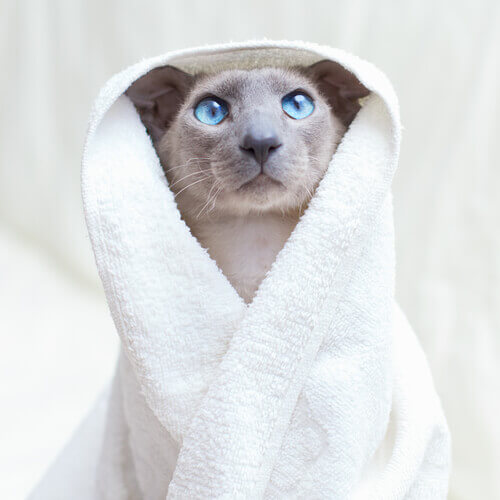How to Bathe Hairless Cats

If you have a hairless cat and you thought that their hygiene would be less hassle, then you’re wrong! These breeds of domestic feline have very sensitive skin, and therefore require special and frequent care. So, today we’ll tell you how to bathe hairless cats.
How to bathe hairless cats: tips
Cats, even hairless ones, are expert bathroom users. But so-called hairless cats – although most breeds have an almost imperceptible layer of fur – tend to sweat more and accumulate more fat and dirt.
If you own one of these cats as a pet, you should bathe it every 20 or 30 days, and you should get them used to this routine from a young age.
If you adopted them as an adult and they don’t like having baths, then there are other options to explore. For example, special wet wipes for cats.
You should always consult the vet, who will inform you about suitable products for washing hairless cats. And they will also discuss techniques that will convince the cat that it needs regular baths.

If you have a hairless cat, you should pay particular attention to its hygiene. Ideally, you should bathe it at least once a month.
Recommendations for bathing hairless cats
The technique for bathing a hairless cat isn’t that much different from a furry cat. However, you have to take extra care on some parts of their body that tend to accumulate more dirt. Therefore, before washing your cat in the bathroom, it’s important to first clean their eyes, nails, and ears thoroughly.
These feline breeds usually have no eyelashes. For this reason, they produce more tears. This prevents pathogens from causing eye diseases. It’s recommended that you clean the eye area weekly with a clean cloth soaked in special serum, which removes dirt and sleep.
These cats usually have larger ears than other cats. Therefore, you should use vet-recommended ear drops to remove earwax.
Step by step guide
Once the cat’s eyes, nails, and ears are clean, the next step is to bath your cat. Remember that the water needs to be a decent temperature, so that your cat is neither cold nor hot, and also that their sensitive skin doesn’t get damaged. Then:
- Slowly wet their whole body, but not their head.
- Gently wash them and pay special attention to their legs and belly.
- Rinse with plenty of water.
- Wash their head, making sure you don’t get water in their nose or eyes.
- Take them out of the tub.
- Dry them with a soft towel, but make sure their skin isn’t wet.

It’s a good idea to create a relaxed atmosphere so that your cat is calm and you can clean them more easily. You’ll also avoid getting scratched.
Consequences of not bathing a hairless cat
Imagine if you didn’t wash your hairless cat, just how much dirt and microorganisms would build up. Sooner or later they’ll suffer from problems on their delicate skin. And they’ll also dirty other things they touch while walking around.
Also, remember that when cats feel dirty they become sad and depressed. So, for the sake of both their physical and emotional health, don’t neglect your hairless cat’s grooming.
The idea is that, even though your cat may resist bathing, you need to persist so that they get used to it, no matter their age. But, in the meantime, don’t miss out on other options to keep your hairless cat clean.
If you have a hairless cat and you thought that their hygiene would be less hassle, then you’re wrong! These breeds of domestic feline have very sensitive skin, and therefore require special and frequent care. So, today we’ll tell you how to bathe hairless cats.
How to bathe hairless cats: tips
Cats, even hairless ones, are expert bathroom users. But so-called hairless cats – although most breeds have an almost imperceptible layer of fur – tend to sweat more and accumulate more fat and dirt.
If you own one of these cats as a pet, you should bathe it every 20 or 30 days, and you should get them used to this routine from a young age.
If you adopted them as an adult and they don’t like having baths, then there are other options to explore. For example, special wet wipes for cats.
You should always consult the vet, who will inform you about suitable products for washing hairless cats. And they will also discuss techniques that will convince the cat that it needs regular baths.

If you have a hairless cat, you should pay particular attention to its hygiene. Ideally, you should bathe it at least once a month.
Recommendations for bathing hairless cats
The technique for bathing a hairless cat isn’t that much different from a furry cat. However, you have to take extra care on some parts of their body that tend to accumulate more dirt. Therefore, before washing your cat in the bathroom, it’s important to first clean their eyes, nails, and ears thoroughly.
These feline breeds usually have no eyelashes. For this reason, they produce more tears. This prevents pathogens from causing eye diseases. It’s recommended that you clean the eye area weekly with a clean cloth soaked in special serum, which removes dirt and sleep.
These cats usually have larger ears than other cats. Therefore, you should use vet-recommended ear drops to remove earwax.
Step by step guide
Once the cat’s eyes, nails, and ears are clean, the next step is to bath your cat. Remember that the water needs to be a decent temperature, so that your cat is neither cold nor hot, and also that their sensitive skin doesn’t get damaged. Then:
- Slowly wet their whole body, but not their head.
- Gently wash them and pay special attention to their legs and belly.
- Rinse with plenty of water.
- Wash their head, making sure you don’t get water in their nose or eyes.
- Take them out of the tub.
- Dry them with a soft towel, but make sure their skin isn’t wet.

It’s a good idea to create a relaxed atmosphere so that your cat is calm and you can clean them more easily. You’ll also avoid getting scratched.
Consequences of not bathing a hairless cat
Imagine if you didn’t wash your hairless cat, just how much dirt and microorganisms would build up. Sooner or later they’ll suffer from problems on their delicate skin. And they’ll also dirty other things they touch while walking around.
Also, remember that when cats feel dirty they become sad and depressed. So, for the sake of both their physical and emotional health, don’t neglect your hairless cat’s grooming.
The idea is that, even though your cat may resist bathing, you need to persist so that they get used to it, no matter their age. But, in the meantime, don’t miss out on other options to keep your hairless cat clean.
This text is provided for informational purposes only and does not replace consultation with a professional. If in doubt, consult your specialist.








